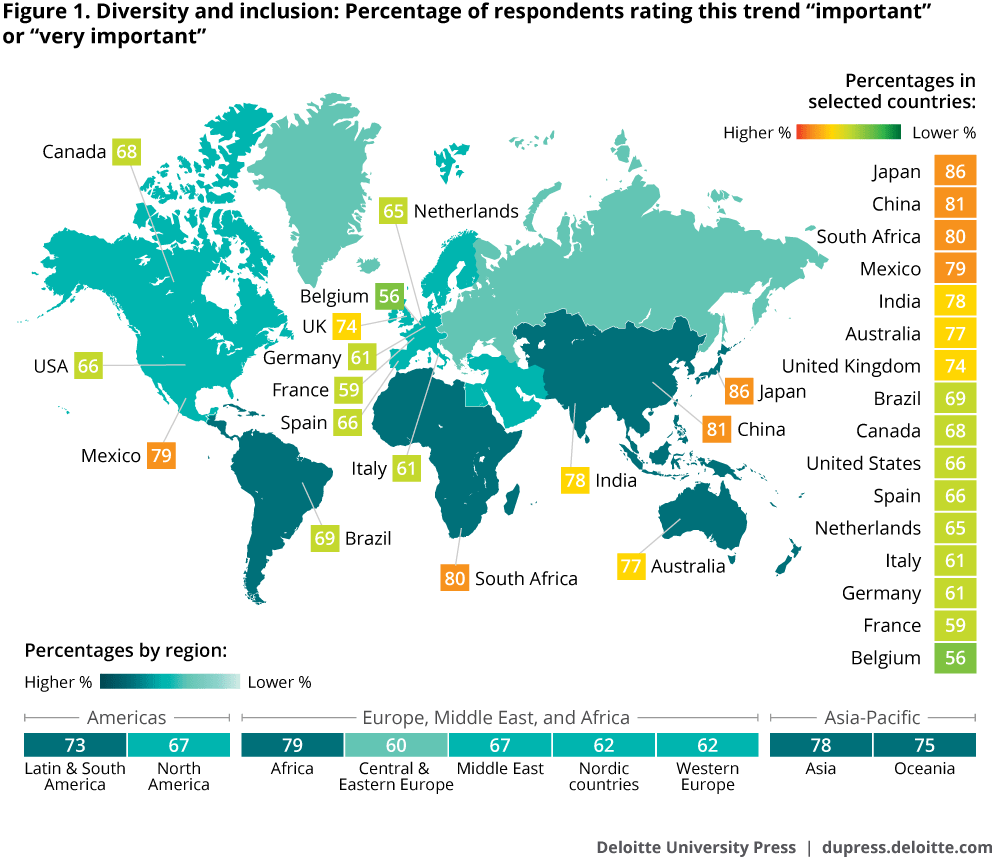Why have Diversity and Inclusion become CEO-level Strategic Concerns?
Research from Deloitte finds that diversity and inclusion in the workplace are now leadership-level issues, central to future growth and security.
Findings from the firm's 2017 Global Human Capital Trends report suggest that diversity has moved away from a predominantly HR-focused, "check box ticking" initiative to one of key strategic importance at CEO-level.
Key findings include:
- The proportion of executives who cited inclusion as a top priority has risen by 32% percent compared to 2014.
- More than 69% of executives rate diversity and inclusion an important issue (up from 59% in 2014).
- Nearly 50% of companies consider themselves adequate at focusing on global cultural diversity.
- 78% of respondents now believe diversity and inclusion is a competitive advantage (39% say it is a “significant” competitive advantage).
Rising Importance of Diversity in Business
"Diversity and inclusion now impacts brand, corporate purpose, and performance. Not only is the public increasingly aware of the issue (witness the scrutiny of gender and racial diversity in the technology industry),1 but employees are also expressing stronger views on diversity and inclusion."
Some of the main drivers the research found behind the rising importance of diversity include:
The Politics of Diversity
The global political environment has made brought diversity to the headlines. Immigration, security, terrorism, identity politics, economic challenges and a whole host of other influences have had an impact on diversity and difference. "The business issue of diversity and inclusion now touches issues of employee engagement, fairness, human rights, and even social justice."
Business is Global and Diverse
The fact that many business have a diverse workplace and/or a global presence means that diversity and inclusion is now a crucial factor at work. Many large companies and organizations now see themselves as transnational and therefore have to embrace cultural, national, reliigious and generational diversity in order to not only succeed, but remain true to their brand values. Training courses to raise awareness of unconscious bias are becoming increasingly popular.
Diversity Means Business
An important factor behind the growing investment in areas such as cross-cultural training is the amount of research that now auggests that multicultural and diverse teams outperform their monocultural counterparts. Business benefits from diversity and as a result business is keen to promote and maintain that diversity. "Companies with inclusive talent practices in hiring, promotion, development, leadership, and team management generate up to 30 percent higher revenue per employee and greater profitability than their competitors."

The Old Models of Diversity Are Dying - How To Keep Up
Deloitte's researchers suggest that old models of diversity and inclusion are undergoing changes and that these changes are set to happen rapidly over the coming years, and this trend is expected to accelerate. As demands change, what can companies do to keep up?
Ensure that top leadership understands the importance of diversity: Share research on the value of inclusion to build consensus at the organization’s highest levels. Then hold top leaders accountable through metrics and transparent reports on diversity in promotion, hiring, and compensation.
Use technology and data to identify problems and measure progress: Analytics can now help in identifying patterns of gender and racial bias, disparities in compensation and rewards, and bias in hiring and promotion. Tools to anonymize resumes and help training managers remove bias should become part of the diversity effort.
Move beyond HR: Consider diversity and inclusion as part of the corporate infrastructure, just like compliance, IT, and security; it must be practiced by everyone and owned by all line leaders. Diversity and inclusion is a business responsibility, not an HR responsibility.
Consider global differences: Geographic diversity is increasingly important as more organizations become global. The specific challenges for diversity and inclusion will likely vary widely from region to region, and employees’ interests and concerns in different regions will likely differ as well.
TO READ THE FULL REPORT, PLEASE VISIT DELOITTE'S 2017 GLOBAL HUMAN CAPITAL TRENDS
Photo by Christina @ wocintechchat.com on Unsplash
Related Posts
By accepting you will be accessing a service provided by a third-party external to https://www.commisceo-global.com./

 +44 0330 027 0207 or +1 (818) 532-6908
+44 0330 027 0207 or +1 (818) 532-6908
